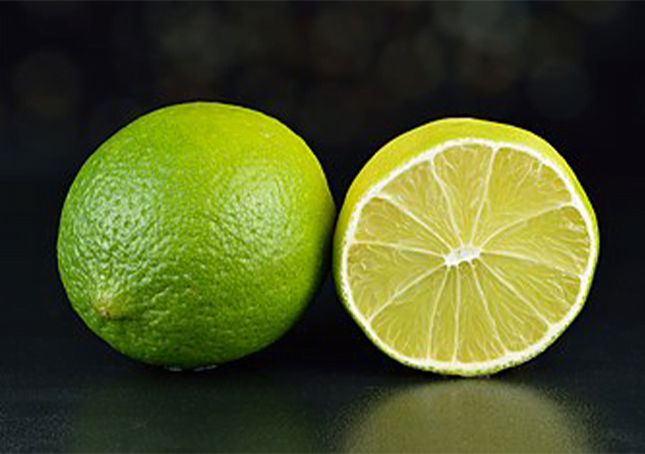Lime (fruit)

A lime (from French lime, from Arabic līma, from Persian līmū, “lemon”),[1] is a citrus fruit, which is typically round, green in color, 3–6 centimetres (1.2–2.4 in) in diameter, and contains acidic juice vesicles.
There are several species of citrus trees whose fruits are called limes, including the Key lime (Citrus aurantiifolia), Persian lime, kaffir lime, and desert lime. Limes are a rich source of vitamin C, are sour, and are often used to accent the flavours of foods and beverages. They are grown year-round.[3] Plants with fruit called “limes” have diverse genetic origins; limes do not form a monophyletic group.
The difficulty in identifying exactly which species of fruit are called lime in different parts of the English-speaking world (and the same problem applies to homonyms in other European languages) is increased by the botanical complexity of the citrus genus itself, to which the majority of limes belong. Species of this genus hybridise readily, and it is only recently that genetic studies have started to shed light on the structure of the genus.
The majority of cultivated species are in reality hybrids, produced from the citron (Citrus medica), the mandarin orange (Citrus reticulata), the pomelo (Citrus maxima) and in particular with many lime varieties, the micrantha (Citrus hystrix var. micrantha).
Most species and hybrids of citrus plants called “limes” have varying origins within tropical Southeast Asia and South Asia. They were spread throughout the world via migration and trade. The kaffir lime, in particular, was one of the earliest citrus fruits introduced to other parts of the world by humans. They were spread into Micronesia and Polynesia via the Austronesian expansion (c. 3000–1500 BCE), as well as into India, Persia, and the Mediterranean region via the spice trade and the incense trade routes from as early as ~1200 BCE.
To prevent scurvy during the 19th century, British sailors were issued a daily allowance of citrus, such as lemon, and later switched to lime. The use of citrus was initially a closely guarded military secret, as scurvy was a common scourge of various national navies, and the ability to remain at sea for lengthy periods without contracting the disorder was a huge benefit for the military. British sailors thus acquired the nickname “Limey” because of their use of limes.
In 2018, world production of limes (combined with lemons for reporting) was 19.4 million tonnes.[13] The top producers – India, Mexico, China, Argentina, Brazil, and Turkey – collectively accounted for 65% of global production (table).
